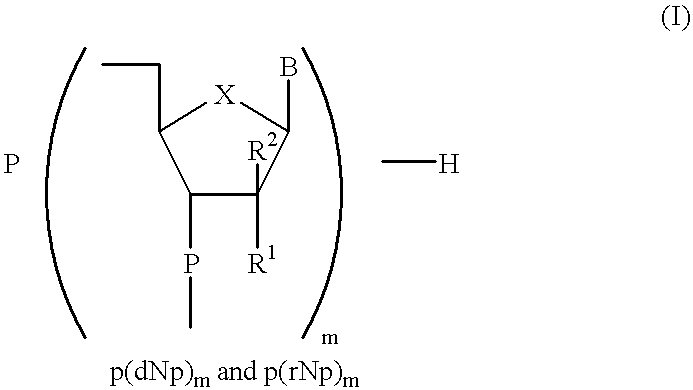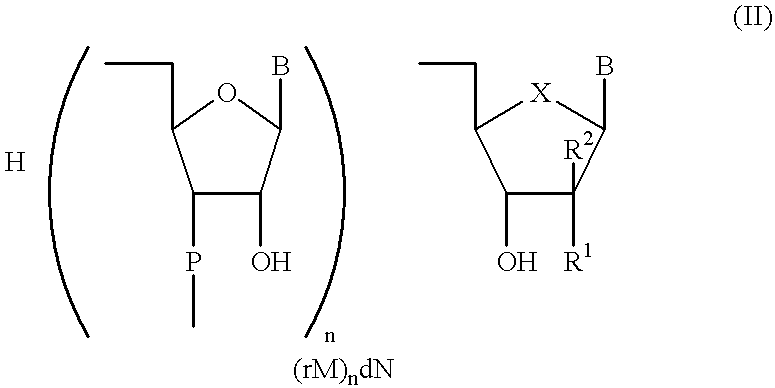Enzymatic methods of preparing polymers from nucleotide and/or non-nucleotide monomers
a technology of nucleotide and non-nucleotide monomers, applied in the field of enzyme-based methods of preparing polymers from nucleotide and/or non-nucleotide monomers, can solve the problems of no oligonucleotide, no method is practical, and limited substrate specificity of reverse transcriptas
- Summary
- Abstract
- Description
- Claims
- Application Information
AI Technical Summary
Problems solved by technology
Method used
Image
Examples
example 1
Preparation 1
In the ligation step comprising activation and ligation, the primer of the general formula p(dNp).sub.m was first activated in the presence of a RNA ligase with ATP, 50 mM HEPPS-NaOH as the buffer at a pH of approx. 8.3, 10 mM MnCl.sub.2, 20 mM DTT, 10 .mu.g / ml bovine serum albumine (BSA) at a temperature of 30 to 35.degree. C. Within the first 3 hours the activation step achieved a yield of 96.8% of activated primer. During the subsequent ligation step the remaining 3.2% were completely reacted. In this step, the activated primer was ligated with the carrier used according to the invention having the general formula (rM).sub.n dN under the same conditions as mentioned above, but without ATP. The ligation reaction proceeded with 100% conversion of the activated primer within about 4.5 hours. Additional information about the identity of the ligation product was provided by alkaline phosphatase treatment as well as mass spectrometric measurement.
Activation and ligation ma...
example 2
Preparation 2
In the ligation step comprising activation and ligation, the primer of the general formula p(rNp).sub.m was first activated in the presence of a RNA ligase with ATP, 50 mM HEPPS-NaOH as the buffer at a pH of approx. 8.3, 10 mM MnCI.sub.2, 20 mM DTT, 10 .mu.g / ml bovine serum albumine (BSA) at a temperature of 30 to 35.degree. C. Within the first 3 hours the activation step achieved a yield of 96.8% of activated primer. During the subsequent ligation step the remaining 3.2% were completely reacted. In this step, the activated primer was ligated with the carrier used according to the invention having the general formula (rM).sub.n dU-rN under the same conditions as mentioned above, but without ATP. The ligation reaction proceeded with 100% conversion of the activated primer within about 4.5 hours. Additional information about the identity of the ligation product was provided by alkaline phosphatase treatment as well as mass spectrometric measurement.
Activation and ligation...
example 3
Preparation 3
In the ligation step comprising activation and ligation, the carrier used according to the invention of the general formula p(rM).sub.n dNp was first activated in the presence of a RNA ligase with ATP, 50 mM HEPPS-NaOH as the buffer at a pH of approx. 8.3, 10 mM MnCl.sub.2, 20 mM DTT, 10 .mu.g / ml bovine serum albumine (BSA) at a temperature of 30 to 35.degree. C. Within the first 3 hours the activation step achieved a yield of 96.8% of activated carrier. During the subsequent ligation step the remaining 3.2% were completely reacted. In this step, the activated carrier was ligated with the primer having the general formula (dN).sub.m under the same conditions as mentioned above, but without ATP. The ligation reaction proceeded with 100% conversion of the activated primer within about 4.5 hours. Additional information about the identity of the ligation product was provided by alkaline phosphatase treatment as well as mass spectrometric measurement.
Activation and ligation ...
PUM
| Property | Measurement | Unit |
|---|---|---|
| temperature | aaaaa | aaaaa |
| pH | aaaaa | aaaaa |
| temperature | aaaaa | aaaaa |
Abstract
Description
Claims
Application Information
 Login to View More
Login to View More - R&D
- Intellectual Property
- Life Sciences
- Materials
- Tech Scout
- Unparalleled Data Quality
- Higher Quality Content
- 60% Fewer Hallucinations
Browse by: Latest US Patents, China's latest patents, Technical Efficacy Thesaurus, Application Domain, Technology Topic, Popular Technical Reports.
© 2025 PatSnap. All rights reserved.Legal|Privacy policy|Modern Slavery Act Transparency Statement|Sitemap|About US| Contact US: help@patsnap.com



